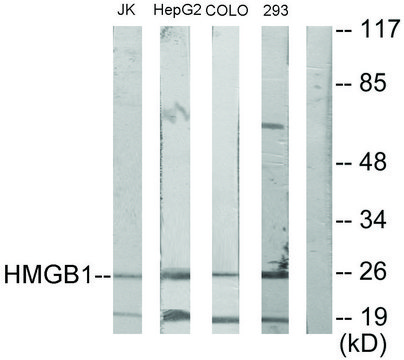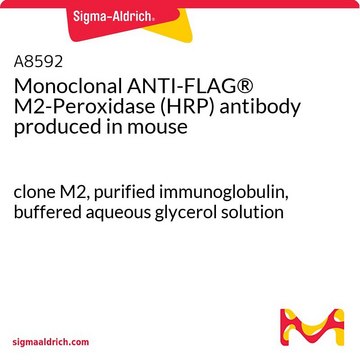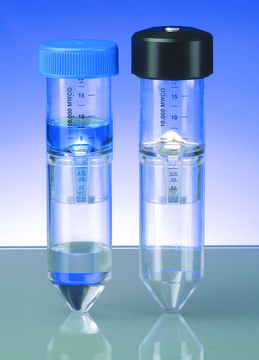추천 제품
생물학적 소스
rabbit
Quality Level
결합
unconjugated
항체 형태
affinity isolated antibody
항체 생산 유형
primary antibodies
클론
polyclonal
양식
buffered aqueous solution
분자량
antigen 25 kDa
종 반응성
human, rat, mouse
향상된 검증
independent
Learn more about Antibody Enhanced Validation
기술
immunoprecipitation (IP): 10 μg using HEK-293T cell lysates
indirect immunofluorescence: 1-2 μg/mL using paraformaldehyde-Triton fixed PC12 cultured cells.
indirect immunofluorescence: suitable
western blot: 1-2 μg/mL using 3T3 cell lysates
UniProt 수납 번호
배송 상태
dry ice
저장 온도
−20°C
타겟 번역 후 변형
unmodified
유전자 정보
human ... HMGB1(3146)
mouse ... Hmgb1(15289)
rat ... Hmgb1(25459)
일반 설명
Anti-HMGB1 (HMG1) (N-terminal) is produced in rabbit using as immunogen a synthetic peptide corresponding to human HMGB1 conjugated to KLH. High Mobility Group B (HMGB) protein family includes HMGB1, HMGB2 and HMGB3, that are highly conserved and indistinguishable in their biochemical properties. HMGB1 is a 25 kDa protein of 215 amino acids and consists of two homologous HMG-boxes rich in basic amino acids, and an acidic tail at the carboxy-terminus.
HMGB proteins belong to the High Mobility Group (HMG) family of proteins that contain the HMG-box for binding and changing DNA structures .
면역원
synthetic peptide corresponding to amino acids 2-17 of human HMGB1, conjugated to KLH. The corresponding sequence is conserved in mouse and rat.
애플리케이션
Anti-HMGB1 (HMG1) (N-terminal) antibody is suitable for use in chemiluminescent immunoblot (using mouse heart homogenates) . The antibody can also be used in immunoprecipitation (10 μg using HEK-293T cell lysates), indirect immunofluorescence (1-2 μg/mL using paraformaldehyde-Triton fixed PC12 cultured cells), and western blot (1-2 μg/mL using 3T3 cell lysates).
Applications in which this antibody has been used successfully, and the associated peer-reviewed papers, are given below.
Western Blotting (1 paper)
Western Blotting (1 paper)
Yale Center for High Throughput Cell Biology IF-tested antibodies. Each antibody is tested by immunofluorescence against HUVEC cells using the Yale HTCB IF protocol. To learn more about us and Yale Center for High Throughput Cell Biology partnership, visit sigma.com/htcb-if.
생화학적/생리학적 작용
High Mobility Group B (HMGB-1 and 2) participate in the regulation of chromatin structure as well as being involved in transcription regulation, DNA repair, recombination, differentiation and extracellular signaling. It shows a defect in transcriptional enhancement of the glucocorticoid receptor, that indicates the important role for HMGB1 in proper transcriptional control by specific transcription factors. Increased expression of HMGB1 is observed in cancer cells.
물리적 형태
Solution in 0.01 M phosphate buffered saline, pH 7.4, containing 15 mM sodium azide.
면책조항
Unless otherwise stated in our catalog or other company documentation accompanying the product(s), our products are intended for research use only and are not to be used for any other purpose, which includes but is not limited to, unauthorized commercial uses, in vitro diagnostic uses, ex vivo or in vivo therapeutic uses or any type of consumption or application to humans or animals.
적합한 제품을 찾을 수 없으신가요?
당사의 제품 선택기 도구.을(를) 시도해 보세요.
Storage Class Code
10 - Combustible liquids
개인 보호 장비
Eyeshields, Gloves, multi-purpose combination respirator cartridge (US)
HMGB1: endogenous danger signaling
Klune J R, et al.
Molecular Medicine, 14(7-8), 476-484 (2008)
David Frescas et al.
Cell cycle (Georgetown, Tex.), 16(16), 1526-1533 (2017-06-27)
Age-related health decline has been attributed to the accumulation of senescent cells recognized in vivo by p16(Ink4a) expression. The pharmacological elimination of p16(Ink4a)-positive cells from the tissues of mice was shown to extend a healthy lifespan. Here, we describe a
J O Thomas
Biochemical Society transactions, 29(Pt 4), 395-401 (2001-08-11)
HMG1 and 2 (high mobility group proteins 1 and 2; renamed HMGB1 and 2) contain two DNA-binding HMG-box domains (A and B) and a long acidic C-terminal domain. They bind DNA without sequence specificity, but have a high affinity for
Michal Stros
Biochimica et biophysica acta, 1799(1-2), 101-113 (2010-02-04)
HMGB proteins are members of the High Mobility Group (HMG) superfamily, possessing a unique DNA-binding domain, the HMG-box, which can bind non-B-type DNA structures (bent, kinked and unwound) with high affinity, and also distort DNA by bending/looping and unwinding. HMGBs
High-mobility group box 1 and cancer
Tang D, et al.
Biochimica et Biophysica Acta - Gene Regulatory Mechanisms, 1799(1-2), 131-140 (2010)
자사의 과학자팀은 생명 과학, 재료 과학, 화학 합성, 크로마토그래피, 분석 및 기타 많은 영역을 포함한 모든 과학 분야에 경험이 있습니다..
고객지원팀으로 연락바랍니다.









